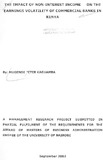| dc.description.abstract | This research project sought out to determine the relationship
between interest income, non-interest income and other incomes of
commercial banks in Kenya and the impact of non-interest income
on the earnings volatility of commercial banks in Kenya. to achieve
these objectives, four regression models were developed using
incomes for the period between 1997 and 2001. Trend analysis was
also conducted to determine relationships between the three main
components of incomes of commercial banks: interest income, non-interest
income and other incomes.
The study found out that interest income on one hand and non-interest
income and other incomes on the other are inversely
related to each other. This implies as non-interest income continues
to grow, interest income will continue to shrink and in the long run,
interest income will no longer dominate bank revenue. This means
banking will have completely shifted away from traditional
intermediation role.
The study results also establishes that increase in the relative
contribution of non-interest income to the total income, an ongoing
trend that may be strengthened by the recent financial
modernization, is associated with both higher earnings volatility and
greater profitability. The increase in profitability reflects an increase
in the risk premium as the banks become more risky (Increase in
the earnings volatility | en |

